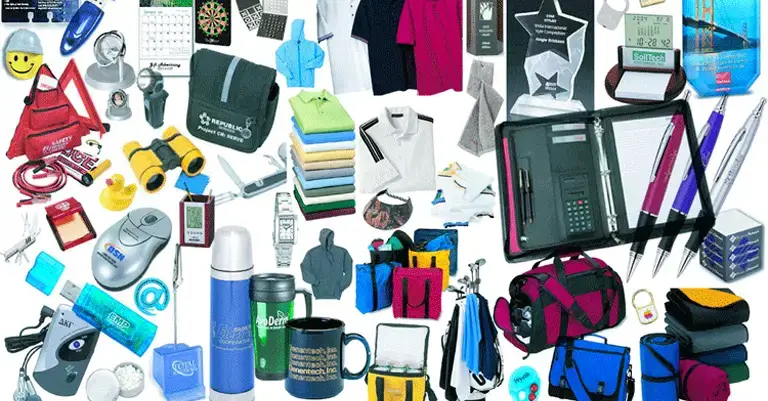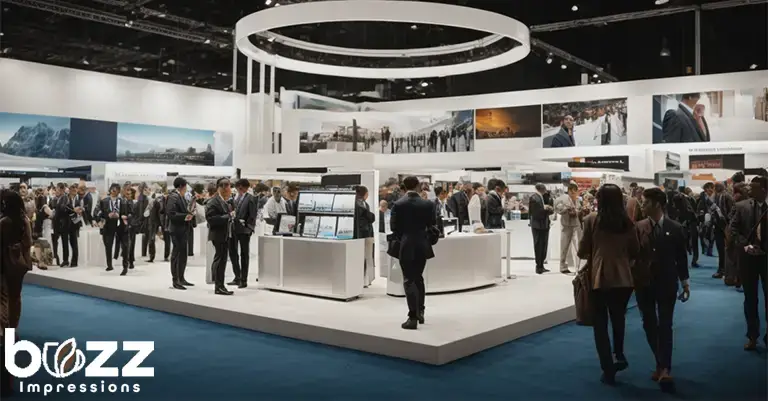Trade show prep is akin to setting the stage for a grand theatrical debut, where every detail counts. This vibrant world can thrust new products to prominence, forge key industry ties, and bolster a brand’s market presence. Yet, it’s not just about standout booths or catchy giveaways. Success hinges on deeply understanding your brand’s essence, uniting your team around a common vision, and resonating with the audience. Without a well-crafted plan, you risk missing potential connections and squandering resources. In this guide, we’ll navigate the intricacies of trade show readiness, emphasizing the importance of a solid foundation, whether you’re a novice or a seasoned participant. Let’s chart the course for success!
Setting Clear Objectives
In the dynamic environment of a trade show, clarity is paramount. To extract the maximum value from these events, brands must have distinct objectives that guide their every move, from booth setup to post-show follow-ups.

Importance of Having Goals
Imagine setting out on a journey without a destination. You might enjoy the ride, but you’ll wander without purpose. Similarly, a trade show without a set goal is like venturing into the wilderness without a map.
Defining a clear goal is the North Star, ensuring you don’t get lost in the crowd. It offers a sense of purpose, streamlines decision-making, and provides a standard against which success can be gauged. By setting a goal, teams can efficiently allocate resources and stay aligned, ensuring that every action contributes to a unified vision.
Examples of Trade Show Objectives
While every brand’s objectives might be shaped by its unique circumstances, some universal trade show goals include:
- Lead Generation: Collecting contacts for future business opportunities.
- Brand Awareness: Amplifying your brand’s presence and reputation.
- Product Launch: Showcasing new offerings and gauging market reception.
- Networking: Building relationships with industry stakeholders.
- Market Research: Understanding market trends and competitors’ strengths.
- Sales: Direct transactions at the show, often accompanied by special deals.
By pinpointing these objectives, brands can ensure their trade show strategies are focused, efficient, and geared towards tangible outcomes.
Understanding the Trade Show Landscape
Diving into trade shows requires more than just a booth and promotional materials. It’s about grasping the bigger picture: the variety of events out there and the changes they’ve undergone. Let’s delve into this intricate landscape.

Trade Show Types and Their Significance
Trade shows come in many flavors, each tailored to specific audiences and objectives:
- B2B Trade Shows: Companies connect with other companies, mainly focusing on bulk deals and partnerships.
- B2C Trade Shows: Businesses interact directly with customers, often leading to immediate sales.
- Industry-Specific Shows: These events cater to specific sectors like tech or fashion.
- International Trade Fairs: Large events that draw participants worldwide, great for global networking.
- Virtual Trade Shows: Digital events that enable participation without geographical constraints.
By recognizing the distinctiveness of each type, businesses can pinpoint where they’ll get the best bang for their buck.
The Evolution of Trade Shows
Trade shows have constantly adapted over time. Here’s a snapshot of how they’ve changed:
- Tech Integration: Modern trade shows often feature tech enhancements, from VR demos to digital networking.
- Eco-Friendly Moves: There’s a growing emphasis on sustainability, from paperless promotions to recyclable booth setups.
- Experiential Trends: It’s no longer just about displays. Attendees now look for interactive and immersive experiences.
- Digital Transition: Events like the pandemic prompted a surge in online or hybrid trade shows, blending physical and digital elements.
- Personal Touch: With data analytics in play, attendees get more personalized experiences, from product suggestions to follow-ups.
Staying updated on these shifts ensures businesses can craft strategies that resonate with the times and the audience.
Choosing the Right Team
Success at a trade show doesn’t solely hinge on the product or the presentation; it’s also deeply intertwined with the people representing your brand. Picking the right team is like casting the perfect ensemble for a play – each member brings unique strengths, and their collective energy sets the stage alight.

Role Specialization
Just as a well-oiled machine has distinct parts performing specific functions, your trade show team should comprise individuals specialized in their roles. Some key roles include:
- Product Specialists: These are the individuals who know your product or service inside out and can address intricate queries.
- Salespeople: Skilled in sealing the deal, they can effectively pitch to potential clients or customers and secure leads or sales.
- Brand Ambassadors: Often the first point of contact, they embody the brand’s image, welcoming attendees and introducing them to what you offer.
- Networkers: These individuals excel in forging meaningful connections, be it with potential partners, industry peers, or influencers.
- Technical Support: If you’re using tech elements like VR or digital demos, having tech-savvy individuals on standby is crucial to troubleshoot any hiccups.
Assigning specialized roles ensures that every aspect of the trade show experience is handled by someone equipped to manage it effectively.
The Significance of On-Ground Charisma
Have you ever been drawn to a booth simply because of the infectious enthusiasm of the person manning it? That’s the power of on-ground charisma. It’s an intangible quality that can significantly amplify your trade show results.
Here’s why charisma is crucial:
- Engagement: Charismatic team members naturally attract and engage attendees, making them more receptive to what you offer.
- Memorability: In a sea of booths, it’s often the interactions with charismatic individuals that attendees remember long after the event.
- Trust Building: People are naturally inclined to trust charismatic individuals, which can be pivotal in establishing credibility for your brand.
- Conflict Resolution: If attendees have grievances or tough questions, a charismatic person can handle them gracefully, ensuring the brand image remains untarnished.
- Boosting Team Morale: A charismatic team member can also uplift the spirits of the entire team, ensuring everyone performs at their best.
In essence, while expertise and knowledge are vital, the human touch – the ability to connect, engage, and inspire – remains invaluable in the trade show arena.
Mastering Your Pitch
Amidst the bustling environment of a trade show, where numerous brands vie for attention, your pitch can be the difference between a pass-by and a potential deal. Crafting that pitch requires a mix of audience insight and storytelling finesse. Here’s how to get it right.

Understanding Your Audience
Before you speak, it’s vital to listen. And in the context of a trade show, this means understanding who you’re speaking to.
- Demographics and Psychographics: Are your attendees young tech enthusiasts or seasoned industry professionals? Knowing this can shape the language, tone, and content of your pitch.
- Their Pain Points: What challenges do they face that your product or service can address? Highlighting solutions to these can make your pitch resonate more deeply.
- Expectations: Are they seeking detailed product information, or are they more interested in hands-on demos? Tailor your approach accordingly.
- Previous Interactions: If possible, glean insights on whether they’ve interacted with your brand before. A repeat visitor may require a different pitch compared to a newcomer.
A thorough understanding ensures that your pitch feels personalized and relevant, rather than generic.
Crafting a Compelling Story
Ever wonder why we love movies or novels? It’s the story that captivates us. Similarly, your pitch should tell a story – one that captivates and convinces.
- Begin with a Hook: Start with a striking fact, a question, or a bold statement that grabs attention immediately.
- Humanize the Narrative: Instead of just presenting facts, weave them into relatable scenarios. For instance, instead of saying “Our software saves time,” you could say, “Remember the last time you missed dinner with your family because of work? Our software ensures you won’t have to.”
- Show, Don’t Just Tell: Utilize visuals, demos, or testimonials to make your story more vivid and believable.
- Conclude with a Call-to-Action: After captivating them with your story, guide them to the next step, be it a product demo, a brochure handout, or a sign-up.
- Be Adaptable: Remember, no two interactions are the same. Be ready to tweak your story based on the audience’s reactions and responses.
In the end, a well-mastered pitch is a blend of understanding and artistry. It’s about connecting, resonating, and leaving an impression that lasts beyond the confines of the trade show.
Designing an Attractive Booth
In the vibrant landscape of a trade show, your booth is your fortress. It’s not just a space to showcase your offerings but a reflection of your brand’s ethos and vision. Crafting the perfect booth requires a careful balance between looks and utility, complemented by the magic of technology.

Aesthetics vs. Functionality
The age-old debate – should it look good or work well? In the world of trade shows, the answer is both.
Here’s how to strike that delicate balance:
- First Impressions Count: A booth that visually stands out can act as a magnet, drawing attendees in. Think bold colors, unique designs, and striking visuals that echo your brand’s identity.
- Space Utilization: While it’s tempting to cram in as much as possible, an overcrowded booth can deter visitors. Ensure there’s enough space for attendees to move, interact, and explore comfortably.
- Accessibility: Design the booth keeping in mind the flow of traffic. Product displays, demo areas, and seating should be placed logically, ensuring attendees can navigate with ease.
- Interactive Elements: Mere aesthetics might attract, but interactive components – like touchscreens or hands-on demo zones – engage. They transform passive observers into active participants.
- Flexibility: Your booth should be adaptable. Depending on the crowd or the time of day, you might want to reconfigure spaces or switch the focus of displays.
By harmonizing aesthetics and functionality, you ensure that your booth not only catches the eye but also offers a memorable experience.
Using Technology to Enhance Experience
The modern trade show booth isn’t just wood and fabric; it’s pixels, waves, and bytes. Integrating technology can elevate the attendee experience manifold. Here’s how:
- Virtual Reality (VR) and Augmented Reality (AR): Transport attendees to a different world, be it a virtual tour of a facility or an augmented display of how a product functions in real-world scenarios.
- Interactive Touchscreens: These can be used for everything from product catalogs to feedback forms, allowing attendees to explore at their own pace.
- LED Displays: Dynamic LED screens can showcase product videos, testimonials, or animated brand stories, adding vibrancy to your booth.
- Digital Brochures: Go green and offer brochures via QR codes. Attendees can scan and get all the information on their phones, reducing paper waste.
- Social Media Integration: Have live Twitter feeds or Instagram walls displaying real-time posts, creating a buzz, and encouraging attendees to share their experiences.
- Chatbots and Digital Assistants: For larger booths, having a digital assistant guide attendee, answer queries, or schedule demos can streamline the experience.
Incorporating technology not only modernizes your booth but also caters to the tech-savvy attendees, ensuring they leave with a blend of awe and appreciation.
Networking Strategies
Trade shows are more than just platforms to showcase products and services. They are vibrant melting pots of opportunities, brimming with potential partners, clients, and industry peers. To truly capitalize on these events, one must master the art of networking. It’s a dance that begins long before the show starts and continues well after the curtains fall.

Importance of Pre-Show Networking
Laying the groundwork before the actual event can drastically amplify your success. Here’s why pre-show networking is indispensable:
- Establish Initial Contact: Reaching out to potential leads or partners before the event can warm them up to your brand, making the in-person meeting more fruitful.
- Agenda Setting: Scheduling meetings or demos in advance ensures you make the most of your time during the show.
- Research: By interacting with attendees beforehand, you can gauge their interests and needs, tailoring your pitch or presentation accordingly.
- Buzz Generation: Engaging with potential attendees on social media or through newsletters can create anticipation around your booth or products.
- Groundwork: Familiarizing yourself with key industry players, competitors, and influencers attending can give you a strategic edge.
By investing time and effort before the event, you position yourself in a proactive stance, ensuring each interaction during the trade show is meaningful and productive.
Maintaining Relationships Post-Show
The end of a trade show is not the finish line; it’s merely a milestone. The relationships cultivated need nurturing to bear fruit. Here’s how to keep the momentum going:
- Timely Follow-Up: Reach out to the contacts you’ve made within a week of the event. A simple ‘thank you for your time’ can go a long way.
- Personalization: Avoid generic emails or messages. Reference specific conversations or moments from the trade show to make your communication memorable.
- Offer Value: Whether it’s a whitepaper, a special discount, or an exclusive webinar, provide something of value in your follow-up, making it beneficial for them to stay connected.
- Engage on Social Media: Add your new contacts on platforms like LinkedIn or Twitter. Share and comment on their posts, keeping the interaction organic and ongoing.
- Feedback Loop: Solicit feedback on your products, presentations, or booth. It shows you value their opinion and are always striving to improve.
- Plan for the Next Touchpoint: Whether it’s a future trade show, a one-on-one meeting, or a virtual catch-up, ensure you have a plan in place for the next interaction.
By fostering these relationships post-show, you transform fleeting trade show interactions into lasting business connections, amplifying the return on your trade show investment.
Incorporating Feedback
One of the most invaluable aspects of trade shows, often overlooked in the dazzle of presentations and pitches, is the feedback loop. Attendees, with their varied perspectives, offer a goldmine of insights that can steer your offerings to better resonate with your target audience. But the trick lies not just in gathering this feedback, but in how adeptly and promptly you incorporate it.

The Power of Live Feedback
When attendees interact with your booth, they’re not just passive observers; they’re active participants, voicing their thoughts, concerns, and suggestions. Here’s why live feedback is pivotal:
- Immediate Insights: Unlike online interactions, trade shows offer real-time feedback. You can gauge reactions, see what piques interest, and what falls flat.
- Diverse Perspectives: Trade shows attract a melange of attendees – from industry experts to potential clients. Each brings a unique viewpoint, enriching your understanding.
- Tangible Product Feedback: If showcasing a product, attendees can interact with it firsthand, giving feedback on aspects like usability, design, and functionality.
- Strengths and Weaknesses: Live demos can spotlight areas where your product shines and where it might need improvements.
- Competitive Analysis: By comparing feedback on your offerings to those of competitors’, you get a clearer picture of your standing in the market.
Leveraging live feedback can be the difference between a good trade show outing and a great one.
Implementing Changes on the Go
While gathering feedback is crucial, the real magic lies in how swiftly you adapt. Here’s how to be nimble-footed:
- Daily Debriefs: At the end of each trade show day, gather your team for a debrief. Discuss the feedback received and brainstorm on immediate tweaks.
- Flexibility in Presentation: If a particular aspect of your pitch isn’t resonating, be ready to modify it for the next day or even the next presentation.
- Interactive Elements: Use digital displays or touchscreens to make real-time changes to product demos or presentations based on feedback.
- Engage Proactively: Instead of waiting for feedback, actively solicit it. Ask open-ended questions to attendees and encourage them to share their thoughts.
- Document Everything: Maintain a live feedback log. This can be a digital document or a physical feedback form where insights are continuously added.
- Immediate Implementation: For feasible changes, like repositioning a product or tweaking a demo, act instantly. This not only improves the attendee experience but also shows them that you genuinely value their input.
Trade shows are dynamic, and so should be your approach. By actively incorporating feedback and iterating on the go, you ensure that your brand remains responsive, relevant, and resonant.
Training and Mock Sessions
Preparing for a trade show doesn’t merely end at designing an attractive booth or crafting a compelling pitch. The real essence of a successful trade show outing lies in the preparedness of your team. Training sessions and mock drills are the back-stage rehearsals that set the stage for the final performance. They equip your team with the confidence and skills to handle varied scenarios and make meaningful interactions.

Role-Play Scenarios
Role-playing is an age-old training technique, and its relevance in trade show prep cannot be overstated. Here’s why:
- Realistic Environment: Role-playing mimics the actual event environment, helping team members get a feel of real attendee interactions.
- Handling Diverse Personalities: Attendees come with different backgrounds, attitudes, and questions. Role-playing helps your team practice tailored responses for varied personalities.
- Feedback Loop: Post role-play, team members can offer feedback, helping each other refine their approach and delivery.
- Boosting Confidence: Practice makes perfect. The more scenarios your team role-plays, the more confident they become in handling real interactions.
- Refining the Elevator Pitch: Role-playing helps team members hone their quick pitches, ensuring they grab attendee attention in those crucial first few seconds.
By simulating real-world interactions, role-playing empowers your team to handle the unpredictability of trade shows with grace and poise.
Addressing Common Queries and Challenges
Every industry and product have a set of common questions and challenges that attendees might pose. Training sessions should focus on these, ensuring the team is well-equipped to address them:
- FAQ Sessions: Compile a list of frequently asked questions and train your team to answer them succinctly and confidently.
- Handling Objections: Not all interactions will be smooth sailing. Equip your team with strategies to handle objections or criticisms gracefully.
- Product Deep Dive: Ensure each team member knows the product or service inside out. This ensures they can address technical or detailed queries with ease.
- Competitor Knowledge: Attendees might draw comparisons with competitors. Equip your team with knowledge about how your offering stands out.
- Scenario-based Training: Create hypothetical scenarios where attendees pose challenging questions or are skeptical. Train your team to navigate these situations diplomatically and convincingly.
- Feedback Mechanism: Encourage team members to share unique queries or challenges they faced post each trade show day. This helps the team prepare better for subsequent days.
A well-prepared team is the linchpin of a successful trade show. Through rigorous training and mock sessions, you ensure that your brand is represented by confident, knowledgeable, and skilled ambassadors.
The Power of Promotional Items
Ah, promotional items! Those nifty little giveaways that attendees so eagerly seek, and brands so generously offer. But these items, often considered mere tokens, hold a much more significant power in the grand scheme of a trade show. They’re not just ‘freebies’; they’re tangible extensions of your brand, leaving a lasting impact on attendees long after the event concludes.

Choosing the Right Giveaways
The landscape of promotional items is vast. From branded pens to tech gadgets, the options can be overwhelming. However, selecting the right item is crucial. Here’s a guide:
- Relevance to Your Brand: Your giveaway should resonate with what your brand stands for. For a tech company, USB drives might be apt; for a health brand, maybe fitness trackers.
- Utility: Items that attendees can use in their daily lives are more likely to be kept. Think tote bags, reusable water bottles, or phone chargers.
- Quality Over Quantity: It’s better to give away fewer high-quality items than a plethora of cheap ones. Quality speaks volumes about your brand’s standards.
- Eco-Friendly Choices: Sustainable giveaways, like biodegradable pens or bamboo cutlery sets, not only serve their purpose but also send a strong message about your brand’s environmental responsibility.
- Uniqueness: Stand out with giveaways that are different from the norm. Think outside the box – maybe a quirky puzzle, a DIY kit, or even seeds to plant!
By carefully selecting your promotional items, you ensure they don’t end up as mere clutter but are genuinely valued by the recipients.
Making a Lasting Impression
The goal of any promotional item is to leave a lasting impression, ensuring your brand remains top of mind. Here’s how to achieve that:
- Personalization: Customizing the item, even if it’s just adding the recipient’s name, can make it special and memorable.
- Share a Story: Attach a small card or note sharing the story behind the item or its relevance to your brand.
- Interactive Elements: QR codes linked to exclusive content or discount codes for your products can turn a simple item into an engaging experience.
- Branding: While it’s essential to have your brand on the item, ensure it’s tastefully done. Oversized logos can sometimes be off-putting.
- Follow-Up: Encourage attendees to share their experience using the promotional item on social media, creating an extended engagement loop.
- Consistency: Ensure that the quality and message of your promotional items align with your broader brand messaging and positioning.
By treating promotional items as more than just giveaways, but as strategic tools, you can ensure they serve as lasting reminders of your brand, continuing the engagement long after the trade show concludes.
Digital Integration
In an era where the digital world is intertwined with our daily lives, it’s impossible to overlook its significance in the context of trade shows. A harmonious blend of offline and online strategies can amplify the reach and impact of your trade show participation. Let’s delve into how integrating digital elements can supercharge your trade show experience.

Social Media Engagement
Incorporating social media into your trade show strategy can open doors to extended networks, fostering real-time interaction and engagement. Here’s how:
- Pre-Show Buzz: Generate excitement by teasing your participation on platforms like Instagram, Twitter, and LinkedIn. Use countdowns, behind-the-scenes looks, or sneak peeks of what to expect.
- Live Updates: Share real-time updates from the trade show floor. Whether it’s a live-tweeting session, Instagram stories, or Facebook Live videos, keep your online audience in the loop.
- Engage with Attendees: Encourage attendees to check-in, tag, or mention your booth on their social channels. Maybe even run a hashtag campaign specific to your brand.
- Interactive Polls & Quizzes: Engage both on-ground and online audiences with interactive polls or quizzes related to your offerings or industry trends.
- Post-Show Highlights: Share a recap of the event, highlighting key moments, interactions, or feedback. It serves as a refresher for attendees and an insight for those who couldn’t attend.
By leveraging social media, you not only extend the life of your trade show interactions but also broaden your reach to global audiences.
Creating a Digital Footprint
Beyond social media, your digital footprint at a trade show encompasses several elements that provide lasting value:
- Virtual Booths: Offer a digital twin of your physical booth for those who can’t attend in person. With 3D tours, video chats, and downloadable resources, virtual booths can mirror the on-ground experience.
- Digital Collaterals: Instead of (or in addition to) physical brochures, offer QR codes that attendees can scan to access digital resources – be it whitepapers, product demos, or exclusive videos.
- Mobile App Engagement: If the trade show has an official app, ensure you have a strong presence on it. Engage with attendees, schedule meetings, or even push notifications about special events at your booth.
- Feedback Loops: Use digital platforms to gather feedback, whether through quick online surveys, direct messages, or email campaigns.
- Post-Show Email Campaigns: Nurture the relationships formed at the trade show through targeted email campaigns, offering further insights, exclusive offers, or simply thanking attendees for their time.
- SEO and Blogging: Post insightful blogs on your website recapping the trade show, sharing industry insights, or delving deeper into topics discussed. This not only boosts your SEO but also positions you as a thought leader.
By weaving digital threads into your trade show fabric, you create a holistic experience, ensuring that your brand’s presence lingers both in the physical and virtual realms.
Post-Show Analysis
The curtains have been drawn, and the trade show floor is quiet once again. But for brands looking to truly capitalize on their trade show investment, the work is far from over. The post-show phase is a critical time to assess, analyze, and adapt. Let’s explore the two essential pillars of this phase: measuring success and gearing up for the next show.
Measuring Success
Determining the ROI of your trade show involvement isn’t just about numbers; it’s about understanding the qualitative and quantitative impacts. Here’s how:
- Lead Analysis: Start by assessing the quantity and quality of leads generated. How many are potential immediate conversions, and how many are long-term prospects?
- Feedback Compilation: Whether it’s from attendees, team members, or partners, gather all feedback. Understand what worked and what needs tweaking.
- Social Media Insights: Dive into the analytics. How much engagement did your posts receive? Did you witness a spike in followers or web traffic during the show?
- Cost vs. Return: Calculate the total expenditure (booth setup, promotional items, team training, etc.) and weigh it against the potential business generated.
- Brand Visibility: While harder to quantify, gauge how your brand visibility has improved post-event. Was there media coverage? An increase in online mentions?
- Attendee Engagement: Assess the quality of interactions at the booth. Were they meaningful and potential business conversations, or just casual visits?
By meticulously measuring these elements, you can paint a comprehensive picture of your trade show success.
Planning for the Next Show
With insights in hand, it’s time to gear up for the future:
- Action on Feedback: Implement changes based on the feedback received. It could be as simple as tweaking your booth design or as significant as redefining your pitch.
- Nurture Leads: The leads you’ve garnered are gold. Implement a targeted post-show communication strategy to nurture these potential clients.
- Document Everything: Create a post-show report, detailing all aspects, from booth traffic patterns to most-asked questions. This becomes a valuable resource for future planning.
- Team Debrief: Sit down with your team. Understand their on-ground experiences, challenges faced, and suggestions for future shows.
- Stay Updated: Trade shows are ever-evolving. Keep an eye on industry trends, emerging technologies, and feedback from other exhibitors.
- Book in Advance: If you’ve identified the next show you want to participate in, book your spot early. This often allows for better positioning, early-bird discounts, and ample preparation time.
Every trade show is a learning experience, a stepping stone to refine and enhance your brand’s presence for future events. The post-show analysis is where these lessons are unearthed and where the foundation for future success is laid.
Closing Thoughts
Trade shows are bustling hubs of brands, ideas, and opportunities. Every phase, from initial preparations to post-show analyses, is crucial in shaping success. Our journey has highlighted that triumph at trade shows demands a mix of strategy, adaptability, and an ongoing learning curve. Brands should approach these events with precision, akin to a painter crafting each brushstroke. Know your audience, tailor your message, and leverage the digital realm to amplify your reach. As you navigate trade shows, value every interaction and feedback. Continuously adapt, and keep your eyes set on the next horizon. Until then, let your brand’s brilliance shine, and let your team celebrate the fruits of thorough planning and execution.




